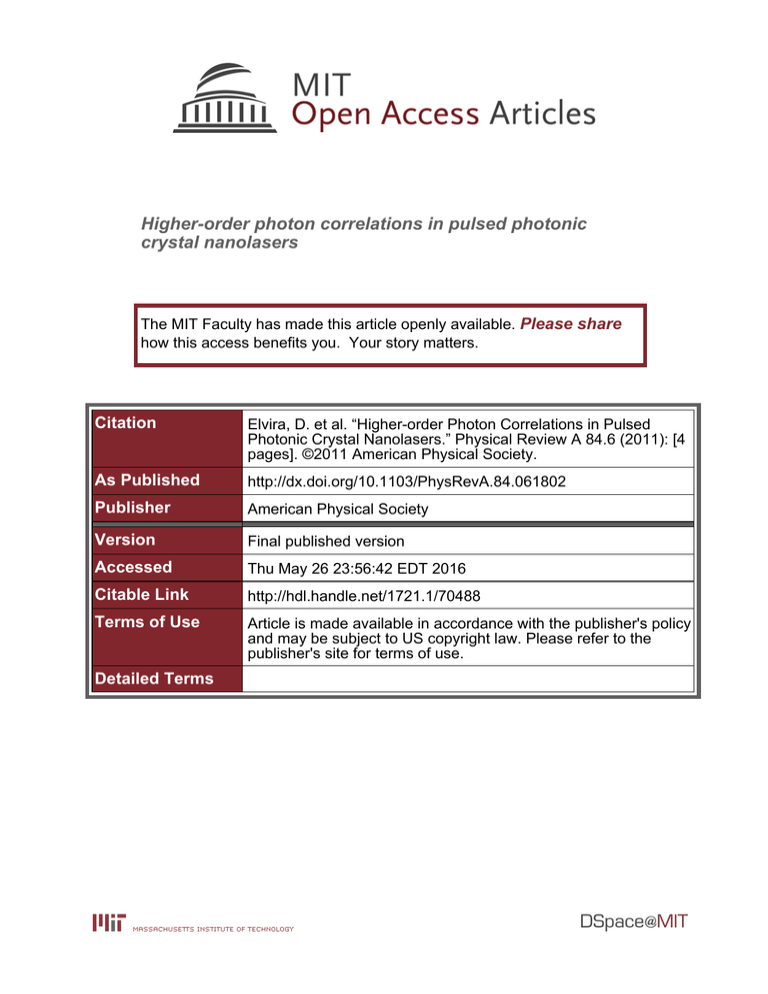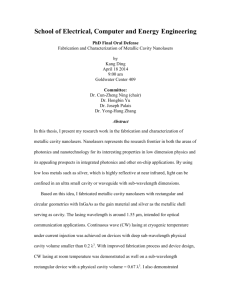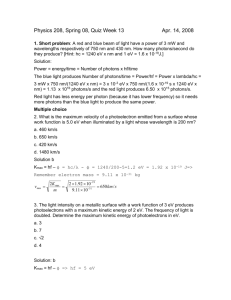Higher-order photon correlations in pulsed photonic crystal nanolasers Please share
advertisement

Higher-order photon correlations in pulsed photonic
crystal nanolasers
The MIT Faculty has made this article openly available. Please share
how this access benefits you. Your story matters.
Citation
Elvira, D. et al. “Higher-order Photon Correlations in Pulsed
Photonic Crystal Nanolasers.” Physical Review A 84.6 (2011): [4
pages]. ©2011 American Physical Society.
As Published
http://dx.doi.org/10.1103/PhysRevA.84.061802
Publisher
American Physical Society
Version
Final published version
Accessed
Thu May 26 23:56:42 EDT 2016
Citable Link
http://hdl.handle.net/1721.1/70488
Terms of Use
Article is made available in accordance with the publisher's policy
and may be subject to US copyright law. Please refer to the
publisher's site for terms of use.
Detailed Terms
RAPID COMMUNICATIONS
PHYSICAL REVIEW A 84, 061802(R) (2011)
Higher-order photon correlations in pulsed photonic crystal nanolasers
D. Elvira,1 X. Hachair,1 V. B. Verma,2 R. Braive,1 G. Beaudoin,1 I. Robert-Philip,1 I. Sagnes,1 B. Baek,2 S. W. Nam,2
E. A. Dauler,3 I. Abram,1 M. J. Stevens,2 and A. Beveratos1,*
1
Laboratoire de Photonique et Nanostructures LPN-CNRS UPR20, Route de Nozay, F-91460 Marcoussis, France
2
National Institute of Standards and Technology, 325 Broadway, Boulder, Colorado 80305, USA
3
Lincoln Laboratory, Massachusetts Institute of Technology, Lexington, Massachusetts 02420, USA
(Received 10 June 2011; published 16 December 2011)
We report on the higher-order photon correlations of a high-β nanolaser under pulsed excitation at room
with
temperature. Using a multiplexed four-element superconducting single-photon detector we measured g (n) (0)
n = 2,3,4. All orders of correlation display partially chaotic statistics, even at four times the threshold excitation
power. We show that this departure from coherence and Poisson statistics is due to the quantum fluctuations
associated with the small number of photons at the lasing threshold.
DOI: 10.1103/PhysRevA.84.061802
PACS number(s): 42.55.Tv, 42.50.Ar, 42.50.Lc, 42.55.Ah
The physics of nanoscale lasers is expected to be radically
different from that of conventional lasers, due to their very high
spontaneous emission ratio (β) into the lasing mode, approaching β → 1. Because of the high β, the system is capable of
lasing with a small number of photons in the cavity mode, of the
order of β −1/2 [1], and thus the stimulated emission threshold
is low and the lasing turn-on time is expected to be very short.
However, the quantum fluctuations associated with the small
number of photons at threshold cause the output intensity of
the laser to fluctuate strongly with chaotic statistics which can
be present well above the stimulated emission threshold [2,3]
and may even suppress continuous-wave lasing [4]. These
small-number fluctuations do not necessarily obey Gaussian
statistics (as is the case for large conventional lasers), and thus
a measurement only of g (2) is not sufficient to characterize
them. A study of these fluctuations requires measurement of
the higher-order correlation functions of the laser output, as
g (2) , g (3) , and g (4) give information on the variance, skewness, and kurtosis (respectively) of the fluctuation statistics.
Understanding these quantum fluctuations is crucial for the
operation of nanolasers, particularly if nanoscale lasers are to
be used in demanding applications, such as interchip optical
interconnects or integrated clocks.
Several studies on the dynamics and the noise characteristics of nanolasers have been reported in recent years.
Measurements of the stationary second-order correlation
function g (2) (τ = t1 − t2 ) were reported some years ago [5,6]
and more recently the evolution of g (2) (t1 ,t2 ) was followed with
picosecond resolution in semiconductor micropillar nanolasers
operated at 4 K in the weak-coupling [7,8] or the strongcoupling [9] regimes. Lately, the noise properties of nanolasers
operating at room temperature were also reported [10]. In
most of these studies, the cavity volume was of the order
of a cubic wavelength and the gain material consisted of
a small number of semiconductor quantum dots. In some
recent work on plasmonic structures, lasers with even smaller
volumes have been reported [11–13], reducing further the
number of emitting dipoles and photons in the cavity. Clearly,
in such small lasers, and in view of the very small number
*
alexios.beveratos@lpn.cnrs.fr
1050-2947/2011/84(6)/061802(4)
of photons at threshold, the traditional laser theories based
on the “thermodynamic limit” of large-ensemble averaging
and continuum approximations for the gain medium and the
electromagnetic field are no longer valid, as the discrete nature
of the number of dipoles and photons must be taken into
account explicitly.
In this Rapid Communication we report an experimental
study of the higher-order photon autocorrelation functions of a
single-mode photonic crystal nanocavity laser, with quantum
dots as its gain material, operating at room temperature, in
the telecommunications wavelength range, and under pulsed
excitation. In the second, third, and fourth orders of correlation,
the output intensity fluctuations display a chaotic component
and deviate from standard Poisson statistics, even at pump
powers of over four times the threshold. These noise properties
can be accounted for by the quantum fluctuations arising from
the small number of photons at threshold, through a simple
model that provides insight into the physics of nanolasers.
The nanolaser cavity is formed by a photonic crystal double
heterostructure [14] etched on a 320-nm-thick suspended InP
membrane [10], grown by metalo-organic chemical vapor
deposition and incorporating a single layer of self-assembled
InAs1−x Px quantum dots [15] at its vertical center plane (See
Fig. 1). The quantum dot density is of the order of 1.5 ×
1010 cm−2 and their spontaneous emission is centered at
∼1560 nm at 300 K with an inhomogeneous linewidth of
∼150 nm. The cavity is fabricated using electron beam
lithography, inductively coupled plasma etching, and wet
etching [16]. The structure consists of a W1 photonic crystal
waveguide composed of one missing row of holes in the -K
direction of a hexagonal lattice structure with a lattice constant
of am = 410 nm, and an air-hole radius of r = 0.293am . The
lattice constant is modified over two periods at the center of
the photonic crystal waveguide along the -K direction alone,
to the value of al = 440 nm, thus forming a nanocavity with an
effective volume of 1.3(λ/n)3 , enclosed by two surrounding
“mirror” waveguides with a smaller lattice constant, and
containing on average some 70 quantum dots. The quality
factor of the cavity is obtained by measuring the coherence
time of the device output when bleaching the quantum dot
absorption [17] and by measuring the cavity ring-down time
through the second-order autocorrelation function well above
061802-1
©2011 American Physical Society
RAPID COMMUNICATIONS
D. ELVIRA et al.
PHYSICAL REVIEW A 84, 061802(R) (2011)
1.4
1.2
1.4
1.2
1
(3) 0.8
g 0.6
0.4
0.2
0
−73.5
1
−49
−24.5
τ1(ns)
FIG. 1. (Color online) Double-heterostructure photonic crystal
cavity. White dashed lines indicate the change in periodicity corresponding to the mirror position. The red arrow shows the laser cavity.
threshold. Both methods give a quality factor of Q = 45 000,
corresponding to a cavity lifetime of 1/ c = 35 ps.
The nanolaser is studied at room temperature. Optical
excitation is provided by a pulsed Ti:sapphire laser emitting
at 805 nm with a repetition rate of 82 MHz. The pump
pulse is broadened to ∼50 ps after passage through a 25-m
length of single-mode optical fiber, and is then focused to
a 5-μm spot on the sample with a microscope objective
[numerical aperture (N.A.) = 0.4]. When the quantum dots
are highly excited and contain several electron-hole pairs, they
emit into a broad spectrum with a lifetime of 1/γ = 400 ps
[10,18] which feeds the cavity mode [19]. Emission from the
nanocavity laser is collected with the same objective, directed
through a dichroic beam splitter that blocks the pump light, and
is sent to a 0.75-m grating monochromator. One output port of
the monochromator holds an image-intensified near-infrared
camera, which records the emitted spectrum and power.
Alternatively, an internal mirror can be flipped, directing
light to the other output port, where it is collected into a
single-mode optical fiber and sent to the detector. The detector
is a four-element superconducting nanowire single-photon
detector (SNSPD) [20] in which four independent, singlephoton-sensitive elements are interleaved over a single spatial
mode of the optical beam [21]. Each element has a system
detection efficiency of ∼1% at 1550 nm and a dark count
rate of ∼100 Hz. The active area of the four-element SNSPD
is matched to the mode diameter of the fiber, allowing all
four interleaved nanowire elements to equally sample a single
spatial mode [21,22]. Fast four-channel electronics record
photon arrival times on each element. These time-tag data
are post-processed to obtain multi-start, multi-stop correlation
histograms between two, three, and four SNSPD elements.
Details on the data processing, including the elimination of
crosstalk among the interleaved detectors, are given in the
Supplemental Material [23].
Figure 2 presents a typical set of normalized experimental
three-photon coincidence data, extracted from the time-tagged
arrivals of photons on the four multiplexed SNSPD detectors.
0
24.5
49
73.5
−49
−73.5
0
−24.5
24.5
49
73.5
τ2(ns)
FIG. 2. (Color online) Third-order autocorrelation function
g (3) (τ1 ,τ2 ) at a pump power P = 2Pth . The tallest bar, located at
τ1 = τ2 = 0, represents g (3) (0,0). The three ridges of elevated bars
The
that fall along τ1 = 0, τ2 = 0, and τ1 = τ2 correspond to g (2) (0).
remainder of the bars have an average value of ∼1.
It corresponds to the third-order autocorrelation function
g (3) (τ1 ,τ2 ) in histogram form.
= 1, whereas for chaotic
For fully coherent light g (n) (0)
(n) (thermal) light g (0) = n!, for all orders n. For partially
coherent light, we may thus define
h(n) =
−1
g (n) (0)
,
n! − 1
(1)
which is a normalized ratio, indicating whether the statistics
are near coherent or chaotic: Below threshold the output light is
chaotic, so that h(n) = 1, whereas above threshold, one expects
a coherent laser output and h(n) → 0 for all n.
In Fig. 3 we present the experimental data and the
theoretical curves (described below) for the light-in–light-out
curve (right-hand axis) and h(n) for n = {2,3,4} (left-hand
axis) as a function of the pump power of the nanoscale
laser under pulsed excitation. The traditional lasing threshold
is clearly identified at the “knee” of the light-in–light-out
curve [1,3] (which corresponds to the inflection point of the
log-log curve), at Pth = 100 μW (=125 μJ cm−2 per incident
pulse), while the β factor is given by the ratio of the two
slopes of the light-in–light-out curve (corresponding to the
“jump” of that curve in log-log scale) of β = 0.008. The
h(n) , which below threshold are equal to 1, steadily decrease
to reach h(2) = 0.05 ± 0.04, h(3) = 0.036 ± 0.02, and h(4) =
0.029 ± 0.015 at P = 4Pth = 400 μW, all significantly higher
than the value of 0 expected for coherent emission. The
are g (2) (0)
= 1.05 ± 0.04, g (3) (0)
=
corresponding g (n) (0)
(4) 1.18 ± 0.10, and g (0) = 1.67 ± 0.34. In other words, the
intensity fluctuations still have a chaotic component at four
times the traditional threshold power, in sharp contrast to the
behavior of conventional lasers (with β ≈ 10−5 ), for which all
h(n) rapidly vanish above threshold.
The persistence of the chaotic component can be simply understood following Refs. [2–4]: Because of the small number
of photons in the cavity at threshold (given by β −1/2 ≈ 11),
061802-2
RAPID COMMUNICATIONS
HIGHER-ORDER PHOTON CORRELATIONS IN PULSED . . .
PHYSICAL REVIEW A 84, 061802(R) (2011)
For each incident power P , Eqs. (2) and (3) are solved many
times (typically 1500), each solution being referred to as a
are calculated
“realization” of the laser operation. The g (n) (0)
as
k=n−1
[s(t) − k]
= t k=0
,
(4)
g (n) (0)
( t s(t))n
FIG. 3. (Color online) Right-hand axis: Experimental (black dots)
and calculated (black line) light-in–light-out curve. Left-hand axis:
Experimental (red circles, green squares, and blue triangles for
n = 2,3,4, respectively) and calculated (continuous lines of the
corresponding colors) values of h(n) as functions of pump power.
The fit of the h(n) data has no free parameters. Inset: Theoretical
light-in–light-out curve in log-log scale. The experimental points
have been normalized by the fit parameters.
a fluctuation of a few units introduces a non-negligible change
in the stimulated emission rate and in the triggering of lasing,
inducing chaotic (thermal) statistics even above threshold.
More quantitatively, we may model our system in terms of
the traditional laser rate equations [3] under the constraint that
the number of excited dipoles N and the number of photons
in the cavity s be integers:
dN(t)
= Pf (t) − γ N(t) − βγ N(t)s(t),
dt
ds(t)
= −c s(t) + βγ N(t) + βγ N (t)s(t),
dt
(2)
(3)
where f (t) is the temporal profile of the pump pulse intensity,
of integral equal to one. For each incident power P , the
rate equations are solved numerically by iterating over a
time step dt, which is small compared with the characteristic
times of the system 1/γ and 1/ c , and using a quantum
jump approach [24] to ensure that N and s are integers: At
each iteration step, the right-hand sides of Eqs. (2) and (3)
are evaluated, taking into account the discrete evolution of
N and s through a sequence of three binomial processes.
First, the number of dipoles having decayed between t and
t + dt is drawn from a binomial distribution with probability
p1 = γ [1 + βs(t)]dt for each one of them to decay. Second,
the decaying dipoles each produce a photon that has a
of entering the cavity. And third,
probability p2 = [1+s(t)]β
1+βs(t)
the photons that have accumulated in the cavity can escape
with probability p3 = c dt. For consistency, we also take into
account Poissonian statistics for the pump, although it does not
alter the overall conclusions. This algorithm is a variation of
those developed for modeling population dynamics in biology
(where populations can only consist of integer numbers of
individuals) [25], however, with binomial rather than Poisson
statistics, because each of the three processes is a partition.
where x denotes the average of x over all 1500 realizations
(individual solutions). As can be seen in Fig. 3, the experimental data are very well described by our model without
any adjustable parameters for the light-in–light-out curve as
well the second- and third-order correlation functions. They
are reasonably well described for the fourth-order correlation
function, considering the large error bars of the measurements
of g (4) (0).
For traditional lasers, quantum noise is introduced in the
classical rate equations by means of a Langevin driving force
with Gaussian statistics [2,3]. This approach, however, is not
suited for high-β lasers, for which threshold is attained with
only a few photons in the cavity. The reason is that the
fluctuation statistics are Gaussian only in the limit of large
numbers of photons (the well-known central limit theorem).
Also, since the populations can take only non-negative integer values, Langevin forces cannot adequately describe the
fluctuations of small numbers of photons and dipoles as they
do not take into account the discrete nature of the particles
and permit excursions into negative numbers. In addition,
Gaussian statistics imply that the higher-order correlation
functions are sums of products of lower-order averages [26],
a condition which is not verified for the actual small-laser
statistics. Alternatively, for small lasers, the discretization of
the numbers of dipoles and photons is usually treated through
a set of master equations for the probabilities of states with
a given number of excited dipoles N and photons s [4].
This approach can be readily implemented in the steady-state
regime [6]. However, for pulsed lasers, it can only be used
for very small systems: It rapidly becomes cumbersome as the
system increases in size, since it requires calculating the time
evolution of a matrix of N × N interdependent probabilities.
On the other hand, our method requires the computation of
independent trajectories (realizations) with at most N jumps.
Beyond the calculational simplicity this allows for a more
intuitive approach to understanding the underlying physical
phenomena.
To gain better insight into the effects of fluctuations, we
present in Fig. 4 the evolution of the number of photons s(t)
for four realizations of the rate equations (dashed lines) at an
excitation power P = 1.8Pth as well as the mean of s(t) over
1500 realizations (solid line). We observe that the individual
realizations are relatively smooth curves with little noise,
but display strong intensity and timing (jitter) fluctuations,
which are correlated: The longer it takes for the pulse to be
formed, the smaller is its intensity, because in the meantime
the number of excited dipoles has decreased. This jitter implies
that the threshold is crossed at random times, confirming
that it is the fluctuations associated with the small number
of photons at threshold that produce the excess noise. The
inset of Fig. 4 represents the statistical distribution of the
integrated pulse area (in number of photons), compared with
061802-3
RAPID COMMUNICATIONS
D. ELVIRA et al.
PHYSICAL REVIEW A 84, 061802(R) (2011)
FIG. 4. (Color online) Dashed lines: Four different realizations
of the stochastic rate equations at P = 1.8Pth . Solid line: The mean
pulse averaged over 1500 realizations. It can be clearly seen that the
longer it takes for the pulse to emerge, the smaller is its amplitude.
Inset: The dots show the statistical distribution of the total number
of photons per pulse at P = 1.8Pth , and the line shows the expected
distribution for Poisson statistics of the same mean.
the Poisson distribution of the same mean. As can be seen
in the inset, the distribution of the number of photons in
a pulse is broader than a Poisson distribution and displays
a lower probability for high-intensity events and a higher
probability for low-intensity events. It cannot be fitted as the
superposition of a Poisson and a thermal distribution, thus
underscoring the non-Gaussian character of the small-number
photon fluctuations. The correlation between the intensity
[1]
[2]
[3]
[4]
[5]
[6]
[7]
[8]
[9]
[10]
[11]
[12]
[13]
[14]
P. R. Rice and H. J. Carmichael, Phys. Rev. A 50, 4318 (1994).
H. F. Hofmann and O. Hess, J. Opt. Soc. Am. B 17, 1926 (2000).
N. J. van Druten et al., Phys. Rev. A 62, 053808 (2000).
K. Roy-Choudhury, S. Haas, and A. F. J. Levi, Phys. Rev. Lett.
102, 053902 (2009).
S. M. Ulrich et al., Phys. Rev. Lett. 98, 043906 (2007).
Y.-S. Choi et al., Appl. Phys. Lett. 91, 031108 (2007).
M. Assmann et al., Phys. Rev. B 81, 165314 (2010).
M. Assmann et al., Science 325, 297 (2009).
J. Wiersig et al., Nature (London) 460, 245 (2009).
R. Hostein et al., Opt. Lett. 35, 1154 (2010).
M. A. Noginov et al., Nature (London) 460, 1110 (2009).
M. T. Hill et al., Opt. Express 17, 11107 (2009).
M. P. Nezhad et al., Nat. Photonics 4, 395 (2010).
B.-S. Song et al., Nat. Mater. 4, 207 (2005).
fluctuations and the jitter implies that late starts are more
probable than early starts, even though the gain medium
can provide more photons at earlier times. The physical
origin of this effect may be similar to the suppression of
continuous-wave lasing due to fluctuations in small lasers,
discussed by Roy-Choudhoury et al. [4]. Fluctuations may
suppress a nascent laser pulse, leading to “false starts” and
delaying the time when the successful laser pulse takes off. The
increased width of the statistics, the asymmetry (skewness),
and the large tails (kurtosis) impact, respectively, the second-,
third-, and fourth-order autocorrelation functions, and cause
to deviate from the value of g(n)(0) = 1, which is
all g (n) (0)
characteristic of coherent emission.
In conclusion, we measured up to the fourth-order autocorrelation function for a photonic crystal nanolaser operating at
room temperature under pulsed excitation. We observe that all
values of the autocorrelation function are significantly above
unity, even at four times threshold, indicating the presence of
chaotic fluctuations in spite of the predominance of stimulated
emission. A model that takes into account the discrete nature of
the number of photons and dipoles successfully describes the
experimental data, providing an understanding of the operation
of the nanolasers. Measurement of the higher-order photon
correlation functions thus opens the way to the study of
very small lasers, whose operation deviates strongly from the
“thermodynamic limit” that governs conventional lasers.
The authors acknowledge financial support from the Triangle de la Physique under the BIRD project and from
the French National Research Agency (ANR) through the
Nanoscience and Nanotechnology Program (Project NATIF
ANR-09-NANO-P103-36).
[15]
[16]
[17]
[18]
[19]
[20]
[21]
[22]
[23]
A. Michon et al., J. Appl. Phys. 104, 043504 (2008).
A. Talneau et al., Appl. Phys. Lett. 92, 061105 (2008).
R. Hostein et al., Appl. Phys. Lett. 94, 123101 (2009).
D. Elvira et al., Phys. Rev. B 84, 195302 (2011)
M. Winger et al., Phys. Rev. Lett. 103, 207403 (2009).
G. N. Goltsman et al., Appl. Phys. Lett. 79, 705 (2001).
E. A. Dauler et al., J. Mod. Opt. 56, 364 (2009).
M. J. Stevens et al., Opt. Express 18, 1430 (2010).
See Supplemental Material at http://link.aps.org/supplemental/
10.1103/PhysRevA.84.061802 for a detailed analysis.
[24] M. B. Plenio and P. L. Knight, Rev. Mod. Phys. 70, 101
(1998).
[25] H. G. Solari and M. A. Natiello, Phys. Rev. E 67, 031918 (2003).
[26] P. A. Lemieux and D. J. Durian, J. Opt. Soc. Am. A 16, 1651
(1999).
061802-4





